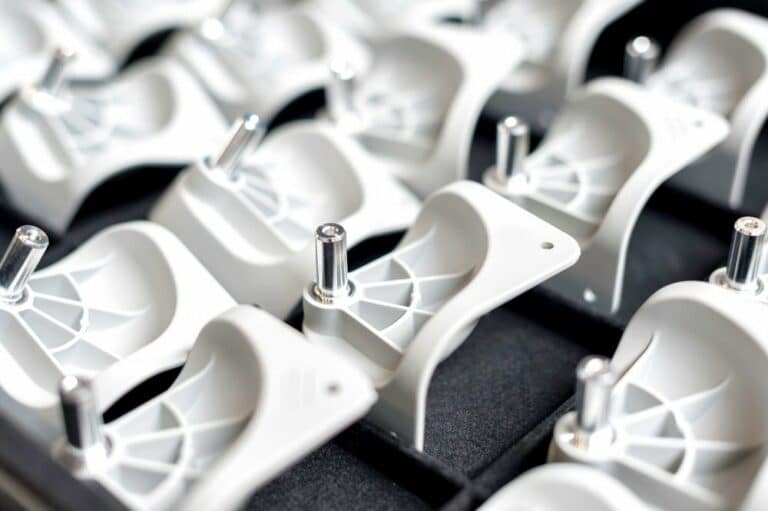
Additional Services Utilized Along with Custom Injection Molding
Having additional services for injection molding allows you to customize your plastic part in many different ways. If you want to achieve characteristics like specific
DISCOVER OUR NEWLY RELEASED COLLECTIBLE DISPLAY CASES! SHOP NOW
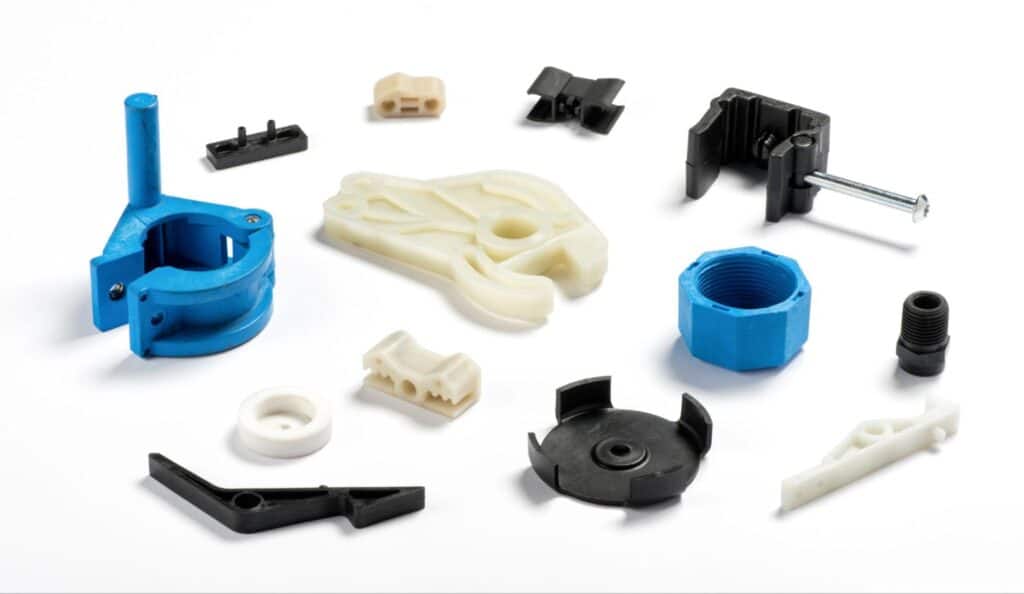
As the demand for higher-performing plastics mounts, advanced features that enhance product usability and aesthetics are becoming more common. However, integrating undercuts, thin walls, living hinges, and other advanced design elements into high-volume injection molding is no simple task. Successfully molding complex plastic parts requires a deep understanding of design for manufacturability principles, close collaboration between design teams and molders, and a mastery of advanced molding techniques.
This guide explores common features in complex injection-molded parts, key considerations for manufacturability, strategies for optimizing design, and tips for collaborating with a reliable injection molding partner.
Discover how Pioneer Plastics—a trusted US-based manufacturer—can help you turn your most ambitious plastic part visions into market-ready realities.
Integrating advanced features into molded parts demands careful design and process planning. Each complex element must contribute to the overall functionality without creating avoidable production issues. Below are some high-impact features that manufacturers often employ to enhance part capabilities.
Designing parts with undercuts can add mechanical functionality such as snap-fit joints or secure threaded inserts. However, they do complicate the molding process, often requiring specialized components like side actions or collapsible cores to release the finished part. For instance, a side action can move or retract after molding to release the undercut safely.
In some cases, slight geometry tweaks, such as tapering undercut surfaces, ensure adequate draft while maintaining structural integrity. These approaches help avoid unnecessary abrasion on the mold while still capitalizing on the functional benefits of undercuts.
Thin-wall injection molding guidelines focus on reducing product weight, shortening cycle times, and minimizing material costs—attractive benefits for industries emphasizing light yet durable parts. However, non-uniform or extremely thin sections can lead to warp, sink marks, or inconsistent material flow. Designers often address these issues by ensuring uniform thickness throughout most of the part and strategically placing gates to control how molten plastic fills the cavity. Proper cooling channel design is equally important, as even temperature regulation helps prevent warping during solidification.
Living hinges serve as built-in pivot points for lids, caps, and enclosures, allowing repeated bending without fracturing. Reference to best practices for living hinges underscores the importance of selecting flexible materials like polypropylene and creating precise geometric configurations. The hinge area is thinned to promote bending, while surrounding structures remain thick enough to maintain overall rigidity. Rounded edges, well-distributed stress points, and consistent molding parameters all help extend the hinge’s lifetime. Since living hinges commonly endure thousands of open-close cycles, robust design is essential to ensure lasting functionality.
Multi-material injection molding overview explains how combining multiple materials in one part—often via overmolding—can unlock superior aesthetics and performance. For instance, a rigid base layer may provide structural strength, while a softer exterior improves grip, impact absorption, or tactile feel. Success depends on ensuring good bonding between the two materials and choosing resin grades that complement each other in terms of melt temperature, shrink rate, and thermal expansion. Properly executed, multi-material parts can dramatically enhance end-use value, particularly in consumer products that must balance comfort and durability.
The quest to integrate advanced features might introduce higher complexity, but robust planning ensures designs are suitable for reliable mass production. From material selection to mold design, taking each step conscientiously reduces the likelihood of defects or expensive last-minute changes.
Engineering-grade plastics such as ABS, polycarbonate, and polypropylene are especially popular when creating advanced features. They provide notable strength, impact resistance, and thermal stability essential for thin walls, undercuts, or living hinges. Each plastic’s unique shrink behavior and flow characteristics must be evaluated to confirm it’s well-suited for the planned design. An inappropriate material choice can translate into part warpage or failures in stress-critical zones, underscoring why thorough testing and prototyping are so valuable.
Moldflow analysis techniques predict how molten plastic fills the mold, pinpointing areas prone to incomplete filling, sink marks, or stress concentrations. By identifying such issues through digital analysis, teams can revise geometries or gating positions before commissioning expensive tooling. Prototyping takes this validation further: physical models, produced through 3D printing or short-run injection molding, serve as tangible checks on functionality and user ergonomics. By uncovering practical challenges early, iteration cycles become more cost-effective and successful.
While small runs can afford somewhat customized processes, large-scale production demands consistency and efficiency. Designers who incorporate scalability from the outset minimize rework if production volumes surge. For instance, gating strategies that enable fast cycle times can save substantial costs when tens of thousands of parts enter production. Likewise, simplified part configurations reduce secondary operations such as trimming or assembly, expediting throughput. Building scalability into the design is vital for companies aiming to respond quickly to market changes or rapidly increasing demand.
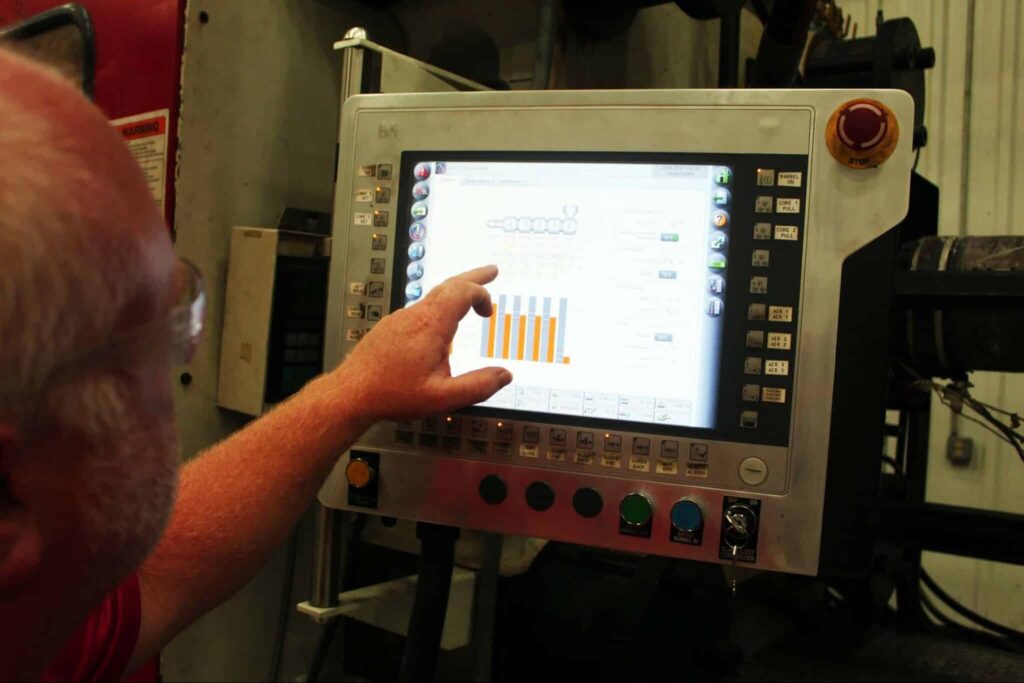
Tooling represents a significant portion of any injection molding investment, particularly for parts with complex geometries. Well-designed molds ensure consistency by aligning with the required tolerances and handling advanced features reliably.
Having an in-house tool building facility allows for close collaboration between engineers and toolmakers. Rather than outsourcing mold construction, Pioneer Plastics and similar manufacturers can integrate design changes swiftly, fine-tune mold components, and address unexpected challenges in real time. This setup not only reduces lead times but also helps preserve design intent.
Proper upkeep follows a guide to mold maintenance, ensuring high-precision molds maintain consistent part quality over time. Routine inspections and preventive care catch small issues—like a loose insert or worn edges—before they escalate into major downtime or defects such as flash. In production environments where speed matters, consistent mold upkeep delivers long-term benefits in responsiveness and part reliability.
Before committing to final tooling, some manufacturers opt for prototype tooling or specialized fixtures that mimic production conditions. Pioneer Plastics, for example, encourages using early runs to validate gating, cooling, and ejection strategies—especially when advanced features introduce potential complexities. By detecting and correcting errors on a prototype tool, teams can proceed with higher-confidence investments in the final production mold. This phase may involve conducting tool adjustment procedures to finalize part consistency and performance.
Complex designs can inadvertently increase material use or prolong cycle times. Fortunately, rethinking geometry or process choices often yields solutions that trim costs and improve throughput. Collaboration between design teams and molders ensures every design element serves a clear purpose.
Although advanced features add value, it’s easy to overcomplicate certain pad structures or threaded inserts. Reexamining whether all specialized details are genuinely needed can reduce tool complexity and the risk of quality issues. For example, some mechanical fasteners might be replaced by carefully designed snap-fit hooks, simplifying assembly. Balancing complexity with necessity supports both manufacturability and the bottom line.
Prolonged cooling is a major factor driving up production time and cost. Cooling channel optimization tips help ensure uniform heat dissipation and shorter cycle times. This not only translates to increased output but also helps preserve part consistency and dimensional accuracy. By collaborating with experts in injection molding, organizations can select designs, materials, and cooling strategies that incrementally shave seconds off each cycle—generating major savings over large production runs.
Partnering with an experienced injection molding company often pays dividends in cost optimization and design success. Pioneer Plastics, for example, blends decades of tool-building knowledge with hands-on insights from various industries, helping clients navigate trade-offs in advanced features. Whether you need short-run injection molding or high-volume production, a reliable partner brings technical depth that ensures your final part meets both performance and budgetary targets. Effective gate design can also make a significant contribution to cycle time reduction and consistent part quality.
Finding the right manufacturing partner can be the difference between a concept stalling at the prototype stage and a market-ready product flourishing in mass production. Pioneer Plastics has more than 40 years of industry experience specializing in custom injection molding, tool building, and engineering services. This wealth of knowledge equips them to tackle intricate geometries, from steep undercuts to ultra-thin living hinges.
Because Pioneer Plastics handles everything from initial consultations to full-scale production under one roof, they can expedite the transition from early design to finished part. Their in-house resources shorten lead times while minimizing communication gaps. Rapid adjustments can be made quickly, and production ramps up with minimal risk of misalignment—all of which helps clients bring products to market faster.
Furthermore, American-made injection molding advantages include local supply chains, consistent quality oversight, and dependable communication. High standards for engineering-grade plastics and tight adherence to design for manufacturability principles lead to stable, repeatable production processes. By streamlining these stages and applying advanced techniques, Pioneer Plastics unlocks the full potential of complex injection-molded part designs, allowing businesses to maintain an edge in their respective markets.
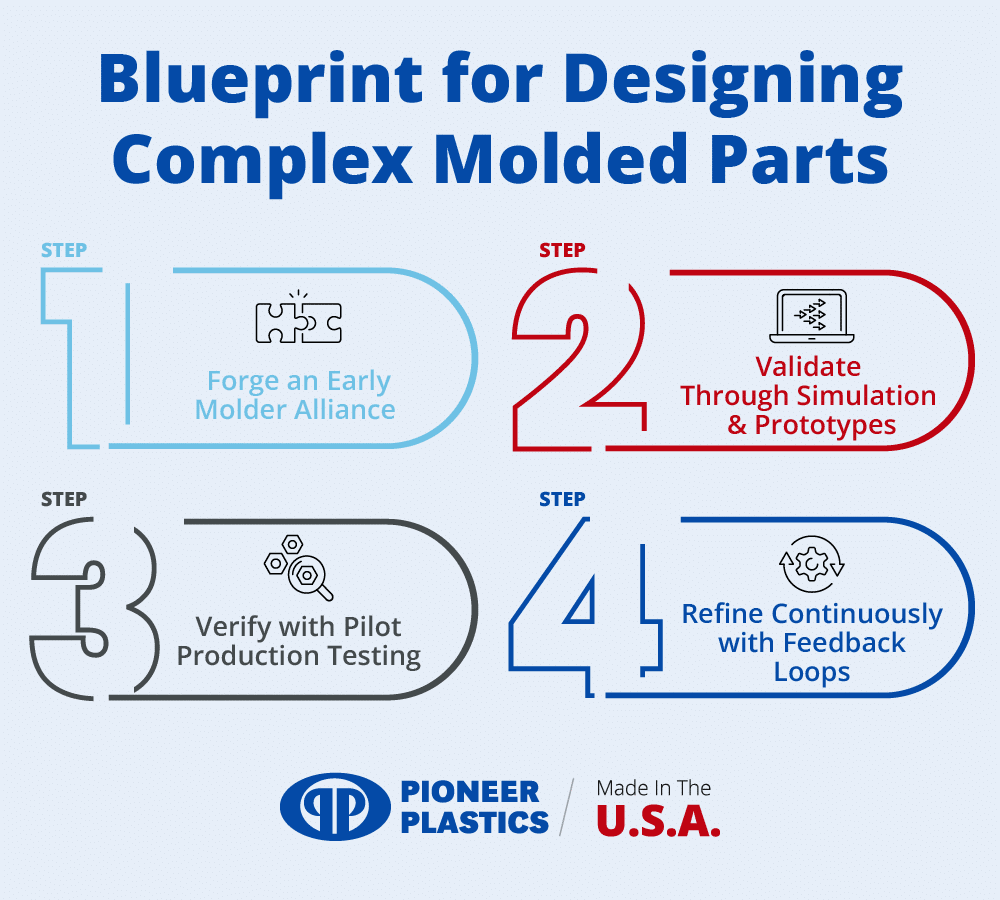
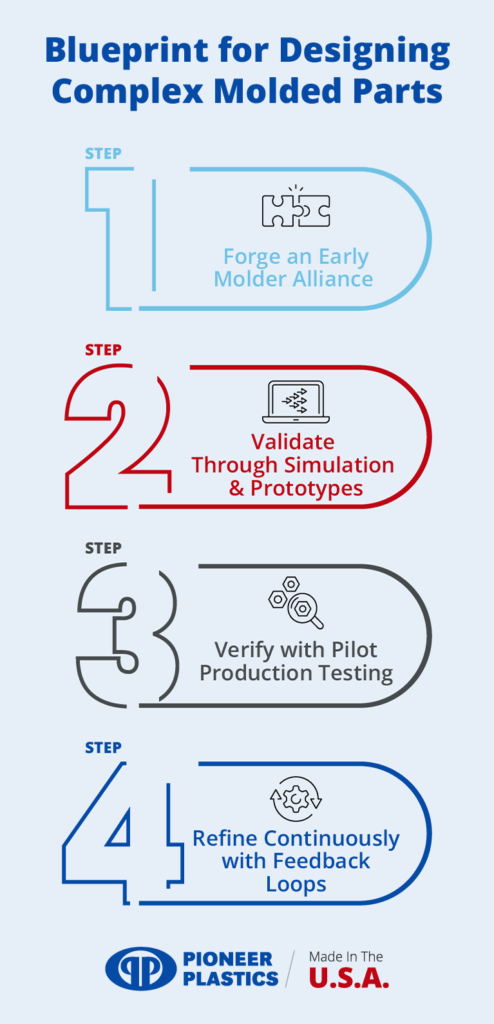
Embedding complexity requires a systematic approach that leaves minimal room for guesswork. Below are key steps that designers, product developers, and engineering teams can take to create intricate, manufacturable parts.
Engaging the molding partner early ensures targeted design reviews and actionable feedback. Even small changes—like adjusting a draft angle or slightly altering wall thickness—can have outsized impacts on mold construction and production efficiency. By involving specialists as soon as possible, teams can avoid costly revisions further down the line.
Leveraging software-based flow simulations helps confirm gating locations, detect potential short shots, and calculate how variations in wall thickness may lead to internal stresses. After digital validation, physical prototypes—whether 3D-printed samples or short-run injection-molded units—provide hands-on checks. If a pivot is needed, these trial runs are typically far less expensive than modifying a full production tool. Consider using 3D-printing vs. custom injection molding comparisons to gauge which methods best suit your project, timeline, and budget.
Pilot runs involve creating a limited set of tools or using production-intent molds at a smaller scale. This intermediate step validates the process settings, identifies any unanticipated issues in material flow, and ensures ejection methods work correctly—even for complex undercuts. Short-run injection molding also offers an opportunity to confirm overall part quality, allowing designers to refine final details before scaling up.
Once production is underway, ongoing data collection pinpoints where performance might be improved without compromising design goals. For example, feedback loops can highlight gating inefficiencies or slight misalignments in mold components. Swift actions—like fine-tuning fill rates or adjusting ejection mechanisms—maintain consistent part quality. Clear, transparent communication with your manufacturing partner ensures everyone remains aligned on cost, schedule, and performance targets.
Complex injection-molded part design holds immense potential for boosting product attractiveness and functionality. Under the right guidance, advanced features like undercuts, thin walls, living hinges, and multi-material solutions can elevate product performance while maintaining cost-efficiency. Pioneer Plastics—a trusted injection molding company with extensive tool-building and engineering services—stands ready to collaborate on challenging projects. Their holistic approach balances innovation with practical manufacturability, driving projects from concept to reality.
If you’re looking for a dedicated partner to turn your most ambitious plastic part designs into commercial successes, contact Pioneer Plastics today. Explore how their engineering expertise, in-house tool building, and rapid production capabilities can streamline your journey toward high-quality, market-ready components.
The information provided in this content is for general informational purposes only and should not be considered professional advice. It is advisable to consult with a qualified industry professional before taking any action based on this information. The team at Pioneer Plastics is here to assist you with any questions you may have.

Having additional services for injection molding allows you to customize your plastic part in many different ways. If you want to achieve characteristics like specific

Selecting a reliable custom injection molding partner goes far beyond a simple procurement decision—it lays the foundation for product success and business growth. Whether you

In the visually driven marketplace of the food industry, clear plastic containers are more than just a means to an end; they are a pivotal